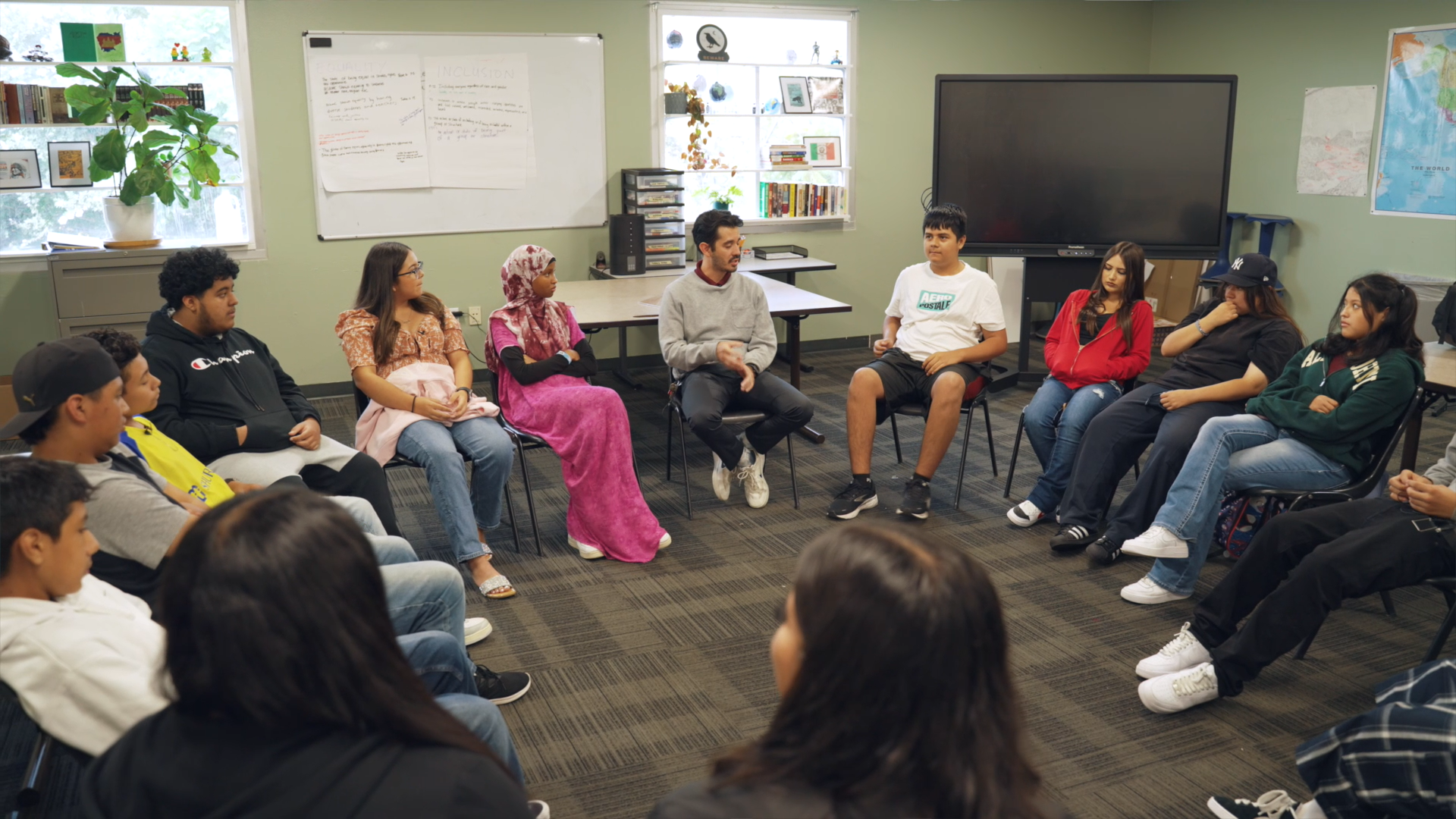By Shawn Slakk
The start of the new school year means setting up your classroom, planning welcome back activities, and participating in professional learning activities.
It’s also a perfect opportunity to collect data and information about your students. Here are a few back-to-school routines that will help you build relationships with your students and the families of your students throughout the year. All of these suggestions can be started as soon as you have your roster.
- Learn about their primary language, schooling, and cultural background
Make a chart, on paper or on a computer— however you work best – and list each incoming student’s name. You can use this chart to make notes about each individual. If you have emergent bilingual students, consider the following: What languages do your students speak at home? Where were they born? How did they come to be enrolled in your classroom? Have they recently immigrated to the U.S. from their home country? How long have they been enrolled in U.S. schools? How long have they been in school at all? Each question should be approached with delicacy and discretion – these questions are not intended to be intrusive, but, rather, to help you better serve students. Each answer will give you insight into your students’ lives and will help avoid incorrect first assumptions.
I’m reminded of a new fourth grader I knew. We’ll call her Yoli. A translator reported that Yoli spoke Spanish when filling out her Home Language Survey at registration. We quickly realized that Yoli didn’t speak a lot of Spanish, even though she was from Mexico. When we chatted with her family, we found out that she had been living with her great-grandmother and great-aunt in Oaxaca who spoke a variation of Mixtec and Nahuatl. She knew some Spanish because in first grade she had attended six months of school, but because her guardians were elderly, she stayed home to help the family, only returning to school in third grade for the last month of school. Then she moved to the U.S. to live with her aunt and uncle who spoke a bit of Mextec, but mostly Spanish. In addition, Yoli’s records never arrived to alert us that she was a SIFE student, having missed more than 2 years of school – something her aunt and uncle didn’t know. She was the correct age for fourth grade, but because she spoke minimal Spanish, it was no wonder we couldn’t get very far in communicating with her in either Spanish, her second language, or English, her third. Therefore, giving her instructions or translating into Spanish didn’t help much.
After learning about Yoli’s real primary language, one of her teachers, Mrs. V, researched the Mixtec language and found the similarities and differences between English and Mixtec. Mrs. V, at that point, gained a better understanding of what letter-sound relationship Yoli already had and used those to help her work with she already knew.
So, what languages do your students speak at home? Check their ELD folder, the registration form and have a conversation with the family when possible. Then research the language to see its language distance or proximity to English and possible cross-linguistic influence. While not every language is a sister language to English, a small amount of work will help you infer what your student might already know, what sounds and letters they might already have connected or what sounds or letters they may never have learned. For older students, if the languages are sister languages, there are as Lems, Miller, & Soro (2017) point out, an abundance of cognates and roots that may help a student see that they already know a good deal of language: they just need guidance in connecting this knowledge to English.
For students with limited or interrupted formal education (SIFE), knowing what years of education and concepts they may have missed in their primary language will help you work on the aspects of schooling that will ultimately help them be successful. In Yoli’s case, she missed quite a lot of the formulative language, writing and beginning framework skills.
2. Learn about their ELD level and their abilities
While you are learning about your students and looking in their cumulative file, check to see what their ELD levels are in the four key language domains: reading, listening, speaking, and writing. Depending upon the state you live in, there may also be comprehension, oral language, literacy, and overall scores. You don’t have to be a data guru to work with these, but do connect with the ESL/ELD teacher for help in understanding all the nuances of the scores and the reports. Add this information to your student information chart. How are they doing in reading? Writing? Listening? What level are they overall? Honingsfeld (2019) explains that some students may be on the same level, but others may have access to some English in movies, songs, or TV and as a result have a different level in different domains.
A highly educated student may be at the Starting or Emerging levels in speaking and listening, but at the Developing or Expanding levels in reading and writing because they have had several years of English in their home country. One such student, Namiko, arrived to our school in the seventhgrade from Japan. Her parents were highly educated and Namiko tested nearly at the Bridging level in reading and Expanding in writing, but at the Emerging level for speaking and listening. After we talked with mom and dad, who both spoke a fair amount of English, we found out that Namiko was very shy and hardly spoke at all in front of anyone, even in Japanese. She had attended an English club at home in Nagoya for a while, helping with what little speaking and listening she had. When the club’s organizer graduated no one else kept the club going. Namiko’s parents already planned to continue her written Japanese education while in the states but realized that they needed to work as a family on oral proficiency in English as well. As a result of the conference, Namiko’s teachers helped her access recordings of texts in English so that she could listen while reading them. They gave her several short but focused one-on-one tutoring sessions in English phonics. Her teachers partnered Namiko with a student who would help her with structure and pronunciation, a pair of fluent readers for Triad Reading and Summarizing to help with fluency and an answer buddy for cooperative learning activities. Soon, Namiko reported that she was helping her parents with English pronunciation and was reading for pleasure in English.
Knowing where your students are in their ELD level can help you with differentiation and aid them in grasping and mastering content and literacy even faster.
3. Make a phone call home
While you have that chart in front of you, call the student’s family. You may need a translator or, as has often happened when I called a student’s home, a student may translate themselves. Even if you don’t speak the language and there is no translator accessible to you, the parents will understand that you are making an attempt to communicate and make them a part of their child’s learning team. The conversation doesn’t have to be long. A two to three minute conversation will help build rapport. “Hi, I’m Oscar’s teacher this year. I wanted to introduce myself. Here is the phone number where I can be reached and here is my email. I look forward to meeting you in person and teaching Oscar. Let me know if you have any questions at any time.” Find a quiet place with a phone at school, or talk with your phone company if you’d rather not have your personal number on the caller I.D. Follow up by sending an email or a note home, or, alternatively, putting the message and contact info on your classroom website as a backup, even if it is in English. It’s possible a sibling, neighbor or relative can help translate.
All of this will take a few hours depending upon what you teach. At one point, I had roughly 130 students a year and I called their households twice each year. While it takes time, it’s worth making the effort to build communication with parents. It also communicates to your students that you care about them. Throughout the year, as new students join your classroom, add them to your information sheet and call home to introduce yourself.
Adding even one of these steps to your start of the year procedures will help you learn about your student and will help then be successful from the start. In the end, being an effective educator means showing your students that you care about them as an individual – and making the effort to learn more about your students and their families is a big first step toward showing them you care.
About the author
Shawn Slakk is CEO and Founder of ABCDSS Consulting Consortium and works with teachers, administrators, and school and state agencies to offer strategies and support for emergent bilinguals and their classmates both K-12 and adults. He is an author, developer and presenter of professional development sessions centered on academic language, literacy and content integration for core-content teachers teaching additional language learners, plus sessions for the coaches and administrators who support them. Find him on Twitter @ABCD2SCo.
References and additional resources
Calderón, M. E., & Slakk, S. (2019). Success with multicultural newcomers & English learners: Proven practices for school leadership teams. Alexandria, VA: ASCD.
Honingsfeld, A. (2019). Growing langauge & literacy strategies for English learners grades K-8. Portsmith, NH: Heinemann.
Lems, K., Miller, L., & Soro, T. (2017). Building literacy with English language learners: Instights from Linguistics (2nd ed.). New York City, NY: Guilford Press.
[1] For a continuum guide of language and literacy in a student’s first language or further discussions on Newcomers, Long-term ELs and years of schooling or in U.S. schools, see chapter 1 of Calderón, M. E., & Slakk, S. (2019). Success with multicultural newcomers & English learners: Proven practices for school leadership teams. Alexandrea, VA: ASCD or visit https://abcd2sco.com/newcomer-resources for an excert containing the continuums.
[2] For more on Language Distance, transfer, and Cross-linguistic influence, see Ch 2 of Lems, K., Miller, L., & Soro, T. (2017). Building literacy with English language learners” Instights from Linguistics (2nd ed.). New York City, NY: Guilford Press or visit https://abcd2sco.com/language-distance for a mini-primmer with activities.
[3] English language development (ELD) levels have many names and variations. Check with your ESL teacher to find out what theoretical frameworks or language development standards your state or country uses or visit any of the following professional organizations for ideas: TESOL.org, WIDA.wisc.edu, or litconn.com for a comparison.
[4] Triad Reading and Summarizing is a variation of Partner Reading and Summarizing. See pages 94 -96 of Calderón, M. E., & Slakk, S. (2019). Success with multicultural newcomers & English learners: Proven practices for school leadership teams.








